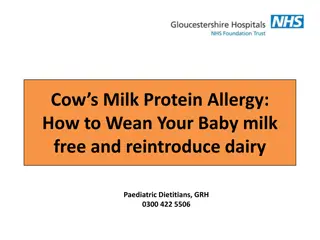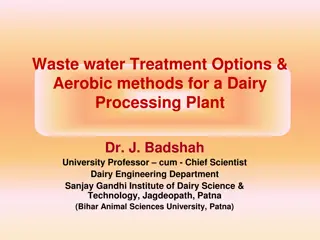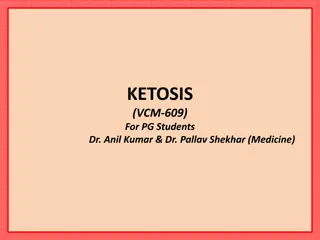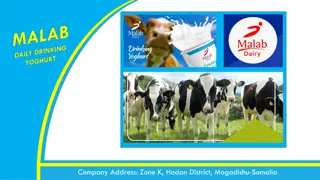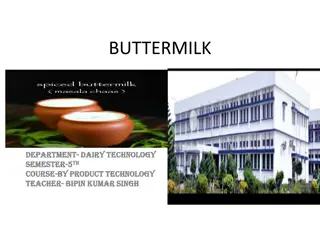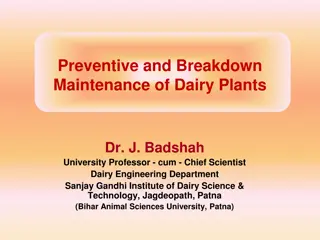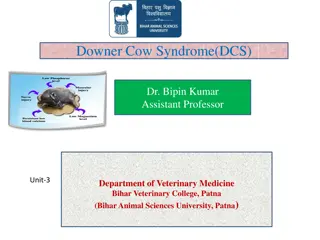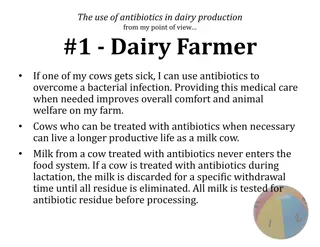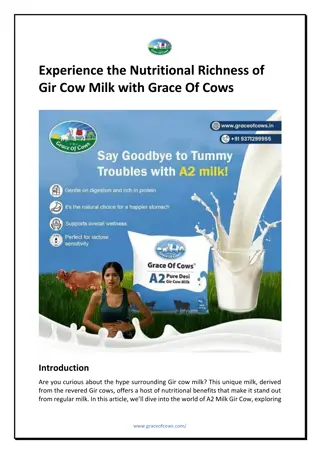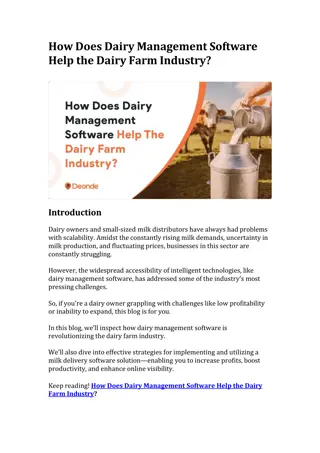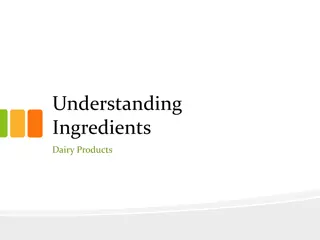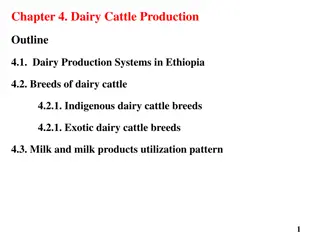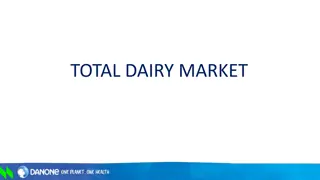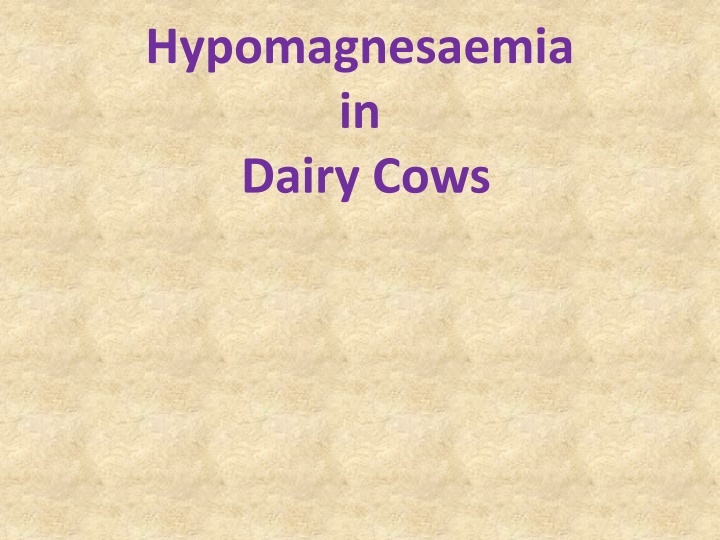
Hypomagnesaemia in Dairy Cows
Explore the causes, occurrences, and impacts of hypomagnesaemia, also known as lactation tetany, in dairy cows. Learn about the importance of magnesium in their diet and how management practices can affect the incidence of this fatal disease.
Download Presentation

Please find below an Image/Link to download the presentation.
The content on the website is provided AS IS for your information and personal use only. It may not be sold, licensed, or shared on other websites without obtaining consent from the author. If you encounter any issues during the download, it is possible that the publisher has removed the file from their server.
You are allowed to download the files provided on this website for personal or commercial use, subject to the condition that they are used lawfully. All files are the property of their respective owners.
The content on the website is provided AS IS for your information and personal use only. It may not be sold, licensed, or shared on other websites without obtaining consent from the author.
E N D
Presentation Transcript
Hypomagnesaemia in Dairy Cows
This hypomagnesaemic tetany of calves group of diseases is divided into Which appears to be due specifically to a deficiency of magnesium in the diet, and lactation tetany, in which there may be a partial dietary deficiency of magnesium but here nutritional or metabolic factors reduce the availability or increase the body's loss of the element so that serum-magnesium levels fall below a critical point
The occurrence is related to three sets of circumstances 1. Most common is occurrence in lactating cows turned out on to lush, grass-dominant pasture in the spring after being confined in closed housing during winters - the classical lactation or grass tetany of Holland 2. The second occurrence is in beef or dry dairy cattle running at pasture in the winter time, usually when nutrition is inadequate and where no shelter is provided in severe, prolonged cold
Lactation tetany: It is also known as hypomagnesaemic tetany, grass tetany and grass staggers Lactation tetany is a highly fatal disease of all classes of ruminants but reaches its highest incidence in lactating cows It is characterized by hypomagnesaemia, and usually hypocalcaemia, muscular spasms and convulsions, and death due to respiratory failure and clinically by
Incidence: Lactation tetany seen in dairy cows turned out to graze on lush, grass-dominant pasture after winter housing is most common in northern Europe and the U.K. and a similar condition occurs in Australia and New Zealand, where the cows are not housed but have access to a phenomenal flush of pasture growth in the spring In all of these forms of the disease the morbidity rate is highly variable, reaching as high as 12 percent in individual herds, and up to 2 per cent in particular areas. The incidence varies from year to year depending largely on management practices climatic conditions and
Etiology: The most constant and significant biochemical disturbance reported in lactation tetany in both cattle and sheep is hypomagnesaemia Hypocalcaemia is often present concurrently and, although it is of less severe degree than in parturient paresis, there is increasing evidence that the actual onset of clinical tetany may be associated with a rapid fall in serum-calcium levels superimposed on a pre-existing seasonal hypomagnesaemia Some attention has been given to the high serum levels of potassium which occur in ruminants on lush grass pasture and green cereal crops, and the relationship of development of tetany hyperkalaemia to the
It seems probable that the mechanism is one of competition with magnesium for absorption, a secondary hypomagnesaemia then being the cause of tetany In view of the estimation that milking cows need to ingest about 20 g and to absorb about 4 g of magnesium daily, the observation that cows fed on winter rations usually receive 32 to 34 g per day and cows on dangerous pasture receive only 10 to 22 g daily is a significant one The critical figure magnesium in pasture is 0.20 per cent. Pasture with magnesium content below this level is likely to cause hypomagnesaemia for concentration of
Apart from the question of the concentration of magnesium in the diet there is the question of the amount of food ingested. A reduction in dry matter intake must reduce the magnesium intake and, in situations where hypomagnesaemia is already present, a further depression of serum-magnesium levels can be anticipated when complete or partial starvation occurs. Whether hypomagnesaemia preexists or not, a period of starvation in lactating cows and ewes is sufficient to produce a marked hypomagnesaemia and the fall may be sufficiently great to cause clinical tetany A number of factors are thought to reduce the availability of the magnesium, which is ingested. Experimental intoxication with ammonia produces a clinical syndrome not unlike that of lactation tetany and it has been suggested that the production of large quantities of ammonia in the rumen when the diet is very rich in protein may, by a process akin to chelation, reduce the availability of magnesium The presence of chelating agents, e.g. alpha keto-butyric acid, in plants or in the ruminal contents is not unlikely and these would of course be inimical to magnesium absorption
Diarrhoea is commonly associated with lactation tetany on spring pasture and by decreasing the alimentary sojourn may also reduce magnesium absorption In areas where the disease is common, grass pastures top dressed with nitrogenous fertilizers are dangerous and their toxicity may be increased by the application of potash. Potash is known to compete with sodium for absorption by plants and, thus interferes with magnesium absorption by them In summary it appears that a number of factors are capable of causing hypomagnesaemia in ruminants and that under particular circumstances one or other of them may be of major importance The major occurrence of lactation tetany is seen in cattle and sheep turned out to lush, grass-dominant pasture in the early spring. Most cases occur during first 2 weeks after the animals are allowed on pasture which has been heavily top dressed with fertilizers rich in nitrogen and potash making them potentially most dangerous. The disease is most common in lactating dairy cattle
Pathogenesis: Most clinical cases of the disease have serum- magnesium levels below 1.0 mg per cent compared with the normal levels in cattle of 1.7 to 3.0 mg per cent and there is a striking relationship between the incidence of the clinical disease and the occurrence of a seasonal hypomagnesaemia The reduction in serum levels of magnesium is concurrent with a marked fall in the excretion of magnesium in the urine
Clinical Findings: Acute lactation tetany: The grazing animal may suddenly cease to graze and adopt a posture of unusual alertness and appear uncomfortable with twitching of the muscles and ears There is severe hyperaesthesia and slight disturbances precipitate attacks of continuous bellowing. The gait becomes staggering and the animal may fall, which is rapidly followed by clonic convulsions lasting for about a minute During these convulsive episodes there is opisthotonus, nystagmus, champing of the jaws, frothing at the mouth, pricking of the ears and retraction of the eyelids Between episodes the animal lies quietly, but a sudden noise or touch may precipitate another attack. Death usually occurs within an hour and the mortality rate is high because many die before treatment can be provided. The response to treatment is generally good
Subacute lactation tetany: In this form of the disease, the onset is more gradual. Over a period of 3 to 4 days there is slight inappetence, wildness of the facial expression and exaggerated limb movements The cow often resists being driven and throws her head about as though expecting a blow. Spasmodic urination and frequent defaecation are characteristic The appetite and milk yield are diminished and ruminal movements decrease. Muscle tremor and mild tetany of the hind legs and tail with an unsteady, straddling gait may be accompanied by retraction of the head Sudden movement, noise, the application of restraint or insertion of a needle may precipitate a violent convulsion Animals with this form of the disease may recover spontaneously within a few days or progress to a stage of recumbency with a similar but rather milder syndrome than in the acute form
Chronic lactation tetany: Many animals in affected herds have low serum-magnesium levels but do not show clinical signs. A few animals do evidence a rather vague syndrome including dull-ness, unthriftiness and indifferent appetite and may subsequently develop one of the more obvious syndromes
Clinical Pathology: The majority of healthy animals will have a serum- magnesium concentration of 1.7 to3.0 mg per 100 ml. These levels in cattle are often reduced in seasonal subclinical hypomagnesaemia to between 1 and 2 mg per cent but tetany is not usually evident until the level falls to below 1.2 mg per cent However, levels may fall as low as 0.4 mg per cent without clinical illness. These discrepancies may be explainable in terms of variations between animals in the degree of ionization of the total magnesium It is also possible that a transitory elevation of the level occurs after violent muscular exercise. Total serum calcium levels are often reduced to 5 to 8 mg per cent and this may have an important bearing on the development of clinical signs. Serum-inorganic-phosphate level may or may not be low
Diagnosis: In coordination, hyperaesthesia and tetany are the major clinical abnormalities, which should arouse suspicion of hypomagnesaemic tetany especially if they occur in ruminants exposed to bad weather or grazing green cereal crops or lush grass dominant pasture. Lactating animals are likely to be affected first. There are many other diseases, which present a similar clinical picture Acute lead poisoning is usually accompanied by blindness and mania, sometimes with an attack complex and there is usually a history of access to lead. The nervous form of ketosis is not usually accompanied by conlvulsions or tetany and there is marked ketonuria
Treatment: The safest general recommendation is to use a combined calcium-magnesium preparation (e.g.500 ml of a solution containing 25 per cent calcium borogluconate and 5 per cent magnesium hypo-phosphite for cattle) intravenously followed by a subcutaneous injection of a concentrated solution of a magnesium salt
Control: Feeding of magnesium supplements. The preventive measure, which is now universally, adopted is the feeding of magnesium salts to cows during danger period. The more common practice is to mix them with molasses and dilute with water which is then sprayed on to the hay/straw. Top dressing of pasture with magnesium-rich fertilizers raises the level of magnesium in the pasture and decreases the susceptibility of cattle to hypomagnesaemia. The magnesium content of pastures can be raised much more quickly by spraying with a 2.0 per cent solution of magnesium sulphate at fortnightly intervals

